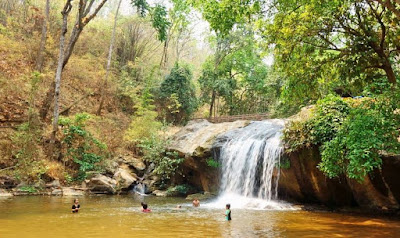Long beset by insurgency, this southern
province bordered by Narathiwat, Yala, and Songkhla has plenty to offer
the visitor
THE FORMER capital of the ancient
Langkasuka Kingdom, Pattani province in Thailand’s far south has
traditionally been feted for its multiculturalism, though sadly the
ongoing violence has kept it well off the tourist path for more than a
decade.
But not all the residents have given up on drawing visitors to their
home. On a recent visit that saw a group of journalists wrap up a tour
of all three southernmost provinces, we were taken around China Town by
Melayu Living, a club of innovative artists who are hoping to bring
tourists back to this thriving trading hub on the bank of the Pattani
River and the border of Thailand and Malaysia.
The group has also collaborated with the Association of Siamese
Architects under Royal Patronage to create maps and guidebooks to
illustrate the city layout and indicate the locations of tourist
attractions.
Along the 1.4-kilometre walking route, visitors can learn about history,
enjoy some local delicacies and get a feel for the simple way of
Southern life. Contrary to the negative pictures painted by the media,
it’s normal to see Muslims sitting alongside Chinese-Buddhists eating
roti and drinking coffee or tea and sharing space in an art gallery.
Sulaiman “Lee” Chemae is our tour guide for the walk and one of my
travel companions greets him not with “hello” but a question – “It is
safe to roam on foot?”
Lee doesn’t appear put out. “This area is like the yolk of an egg,
protected by checkpoints controlled by armed soldiers. So, yes, tourists
can feel safe. I admit we can’t guarantee 100-per-cent safety but we
can recommend places to which visitors can go as well as those best
avoided,” he says.
.
.
China Town is populated by Hokkian Chinese, whose ancestors migrated
from Fujian and set up shop on Anoru Road. Lined with old Chinese-style
buildings mostly constructed during the reign of King Rama III, it’s
home to the Lim Ko Nieo Shrine, worshipped by local residents and
seafarers alike to ask for fortune, success, good health and protection.
Built in 1634, it was originally called Leng Chu Kiang Shrine.
Legend has it that Lim Ko Niao crossed the South China Sea from China to
Pattani to bring her brother back home to be with their dying mother.
The young man, Lim To Kiam, declined her request, preferring to stay in
Pattani because he had married a daughter of Phraya Tani and converted
to Islam. Lim Ko Niao was frustrated by her brother’s refusal and ended
up hanging herself from a cashew nut tree. The villagers later carved a
wooden statue to her memory.
A short distance from the shrine is the former residence of taxman
Luang Wichit Sulkakorn. Made from wood and cement, the main structure
has been maintained to celebrate its long history.
When Wichit and his family moved out, the house was turned into a Thai
dessert shop by Xuan Lui Kowittaya and became the first grocery on Anoru
Road. Today, it’s under the care of the Kamolwittaya family.
“In the past, the Chinese residents traded with sea merchants from
Singapore, Malacca and the Malay Peninsula, while the Muslims made their
living from fishing. King Rama III recognised the potential for border
trade, so he sent a tax collector to Pattani, making our community
stronger,” Lee explains.
Next door is the White Building, which was constructed in 1883 by Luang
Cheen Kananurak. Anan, the third generation of the Kananurak family,
recently had it completely refurbished and gave it a more modern look.
The building is divided into three zones linked by walkways from the
front building to an old wooden house in the middle. There is a kitchen
and a lush courtyard at the back, where the air-raid shelter hastily
constructed during World War II, has been turned into a fish and lotus
pond.
Commonly known as Baan Kongsee, the bright blue, 150-year-old house was
constructed by another tax collector, Luang Samret Kitjakorn Jangwang –
an ancestor of the Kanaurak family, during the reign of King Rama III.
The roof has a perforated design that resembles ancient currency,
symbolic of fortune, while the front of house features two windows to
protect against inauspicious happenings in line with feng shui beliefs.
The structure is built with glazed bricks coated with white honey-mixed
lime and oversize earthenware tiles cover the floor. The living room has
a huge stand to accommodate the many statues of Chinese deities.
“Before the violence, this area was really colourful. It was lined
with restaurants and always packed with foreign labourers and local
fishermen. Because of its proximity to the huge fish market and pier,
some Bt100 million changed hands every night,” Lee says.
“We want to promote other tourist routes that take in artisan villages
and encourage people to take a cruise to a swamp forest in Yaring
district so that visitors can experience our culture.”
Just a 15-minute drive away from downtown Pattani next to Her Royal
Highness Princess Galyani Vadhana Garden is the recently opened Pattani
Adventure Park, which is billing itself as the best vantage point for
admiring Tachee Cape and azure waters of the Gulf of Thailand.
The 400-metre skywalk stands as high as a three-storey building and can
hold up to 400 kilogram per square metre, thus ensuring safety for all
visitors. It’s also connected to a long nature trail on the ground, home
to a lush massive swamp forest.
A mere 35 kilometres from town is
Sai Khao, which won the Most Outstanding Community-based Tourism Award
back in 2007 for its eco-cultural tours and homestay services. Local
residents have modified their vintage Jeep trucks to transport visitors
to the Namtok Sai Khao National Park, where a golden statue of the
Buddha looks down at visitors from the top of the mountain.
“The province invested Bt32 million to construct the Buddha statue
and it took 41 years to complete. It is a great viewpoint to look out
over the verdant landscapes of Sai Khao district,” says Uncle Chanin
Siannin, the head of Baan Sai Khao community.
The mountain is also home to a sacred pond, which the monk Luang Pu Tuad
discovered during a pilgrimage in the jungle, a huge snake-like rock
attached to the steep cliff and the Sai Khao waterfall, which is a
popular picnic spot for local families.
Our day out ends with a visit to the massive rubber plantations and
orchards, where we’re allowed to pick durian, bananas and rambutan
straight from the tree and stock up on such snacks as preserved garcinia
and miang kham made from banana to remind us of our visit.
Source - TheNation











































